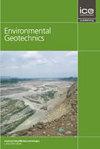Increased Microbially Induced Calcium Carbonate Precipitation (MICP) Efficiency in Multiple Treatment Sand Biocementation Processes by Augmentation of Cementation Medium with Ammonium Chloride
IF 2.2
4区 工程技术
Q3 ENGINEERING, GEOLOGICAL
引用次数: 0
Abstract
The cementation medium for ureolytic microbially induced calcium carbonate precipitation (MICP) typically consists of urea and a calcium source. While some studies have augmented this basic medium, the effects of adding substrates such as ammonium chloride are unclear. The studies detailed in this paper sought to quantify the effect of the ammonium chloride augmentation of cementation medium (CM) on the process of MICP. An aqueous MICP study was initially carried out to study the effects of adding ammonium chloride to the urea–calcium cementation medium. This batch test also explored the effect of varying the concentration of calcium chloride dihydrate (calcium source) in the CM. A subsequent sand column study was undertaken, whereby multiple treatments of CM were injected over several days to produce a biocement. Six columns were prepared using F65 sand bioaugmented with Sporosarcina pasteurii, half of which were injected with the basic medium only and half with the augmented medium for treatment two onwards. Effluent displaced from columns was tested using ion chromatography and Nesslerisation to determine the calcium and ammonium ion concentrations, respectively, and hence the treatment efficiency. Conductivity and pH testing of effluent gave insights into the bacterial urease activity. The addition of 0.187 M ammonium chloride to the CM resulted in approximately 100% chemical conversion efficiency within columns, based on calcium ion measurements, compared to only 57% and 33% efficiency for treatments three and four, respectively, when using the urea–calcium medium. Columns treated with the CM containing ammonium chloride had unconfined compressive strengths which were 1.8 times higher on average than columns treated with the urea–calcium medium only.氯化铵强化胶结介质提高多处理砂生物胶结过程中微生物诱导碳酸钙沉淀(MICP)效率
用于溶尿微生物诱导碳酸钙沉淀(MICP)的胶结介质通常由尿素和钙源组成。虽然一些研究已经增加了这种基本介质,但添加底物如氯化铵的效果尚不清楚。本文详细的研究旨在量化胶结介质(CM)的氯化铵增强对MICP过程的影响。为了研究在尿素-钙胶结介质中加入氯化铵的效果,初步进行了水相MICP研究。本批试验还探讨了不同浓度氯化钙(钙源)在CM中的作用。随后进行了砂柱研究,在几天内注入多次CM处理以产生生物水泥。用F65培养基制备了6根巴氏孢子孢杆菌生物增强柱,其中一半只注射基本培养基,一半注射增强培养基,进行第2次处理。用离子色谱法和neslerisation法分别测定从柱中排出的废水的钙离子和铵离子浓度,从而测定处理效率。废水的电导率和pH值测试对细菌脲酶活性有深入的了解。在CM中添加0.187 M氯化铵导致柱内化学转化效率约为100%,基于钙离子测量,相比之下,当使用尿素-钙培养基时,处理3和处理4的效率分别只有57%和33%。含氯化铵CM处理柱的无侧限抗压强度比仅用脲钙介质处理柱平均高1.8倍。
本文章由计算机程序翻译,如有差异,请以英文原文为准。
求助全文
约1分钟内获得全文
求助全文
来源期刊

Environmental geotechnics
Environmental Science-Water Science and Technology
CiteScore
6.20
自引率
18.20%
发文量
53
期刊介绍:
In 21st century living, engineers and researchers need to deal with growing problems related to climate change, oil and water storage, handling, storage and disposal of toxic and hazardous wastes, remediation of contaminated sites, sustainable development and energy derived from the ground.
Environmental Geotechnics aims to disseminate knowledge and provides a fresh perspective regarding the basic concepts, theory, techniques and field applicability of innovative testing and analysis methodologies and engineering practices in geoenvironmental engineering.
The journal''s Editor in Chief is a Member of the Committee on Publication Ethics.
All relevant papers are carefully considered, vetted by a distinguished team of international experts and rapidly published. Full research papers, short communications and comprehensive review articles are published under the following broad subject categories:
geochemistry and geohydrology,
soil and rock physics, biological processes in soil, soil-atmosphere interaction,
electrical, electromagnetic and thermal characteristics of porous media,
waste management, utilization of wastes, multiphase science, landslide wasting,
soil and water conservation,
sensor development and applications,
the impact of climatic changes on geoenvironmental, geothermal/ground-source energy, carbon sequestration, oil and gas extraction techniques,
uncertainty, reliability and risk, monitoring and forensic geotechnics.
 求助内容:
求助内容: 应助结果提醒方式:
应助结果提醒方式:


